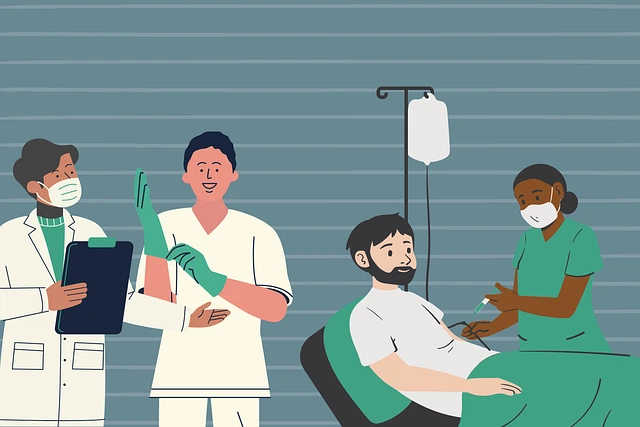Translation services for Patient Discharge Summaries (PDS) in the UK are essential for ensuring regulatory compliance and effective communication. These services help healthcare providers meet standards set by bodies like the Care Quality Commission (CQC), especially when catering to a diverse patient population. Professional translators, skilled in medical terminology and cultural nuances, provide accurate translations of complex medical information in patients' native languages. This not only improves patient safety but also streamlines handover processes between healthcare providers and community services. Case studies show that engaging these services can significantly reduce errors, enhance regulatory compliance, and facilitate smoother patient transitions in multicultural urban settings.
In the UK healthcare landscape, accurate translation of patient discharge summaries is paramount for regulatory compliance. These documents, detailing a patient’s treatment and recovery, must be accessible and understandable to all stakeholders, including those for whom English is not their first language. This article explores the intricacies of translating discharge summaries, highlighting the crucial role of professional translation services in ensuring patient privacy, safety, and legal adherence. We delve into regulatory requirements, challenges, best practices, and successful case studies, offering a comprehensive guide for healthcare providers seeking to navigate the complex world of translation for compliance.
- Understanding Discharge Summaries and Regulatory Requirements in the UK
- The Role of Translation Services in Healthcare Documentation
- Challenges in Translating Patient Records for Compliance
- Ensuring Accuracy and Quality in Medical Translation
- Best Practices for Integrating Translation into Discharge Summary Workflows
- Case Studies: Successful Translation for Regulatory Compliance
Understanding Discharge Summaries and Regulatory Requirements in the UK

In the UK, Patient Discharge Summaries are crucial documents that outline a patient’s healthcare journey and treatment plan following hospitalisation. These summaries serve as a bridge between healthcare providers and patients, ensuring everyone is aligned post-discharge. They encompass vital information such as diagnosis, treatment details, medication instructions, follow-up appointments, and care recommendations. Accurate translation services for Patient Discharge Summaries UK are essential to meet regulatory requirements and guarantee patient safety, especially in a multicultural healthcare setting.
Regulatory bodies like the Care Quality Commission (CQC) mandate that healthcare facilities provide clear, comprehensible discharge documents in both written and oral forms. This ensures patients can make informed decisions about their health and continue their care appropriately. Translation services play a pivotal role here by offering professional solutions to bridge the language gap. They ensure that non-English speaking patients receive summaries in their native language, enhancing understanding, compliance, and overall patient outcomes.
The Role of Translation Services in Healthcare Documentation

Translation services play a vital role in ensuring regulatory compliance within healthcare documentation, especially when it comes to patient discharge summaries in the UK. With an increasing number of multicultural patients and healthcare professionals, accurate and reliable translation is essential to bridge communication gaps. These services provide a means to convey critical information about a patient’s condition, treatment, and aftercare instructions in a language that is easily understandable for both patients and medical staff.
Professional translation companies employ skilled linguists who are well-versed in medical terminology to translate discharge summaries from English into other languages. This process ensures that patients from diverse linguistic backgrounds receive clear and concise documentation, empowering them to actively participate in their healthcare decisions. Effective translation also facilitates seamless handover between healthcare providers, hospitals, and community services, maintaining continuity of care regardless of language barriers.
Challenges in Translating Patient Records for Compliance

The process of translating patient discharge summaries for regulatory compliance presents several unique challenges, especially in a country like the UK with its diverse linguistic landscape. One of the primary hurdles is ensuring accuracy and precision while maintaining the critical information conveyed within these records. Medical terminology can be complex, with nuances that often don’t translate directly from one language to another. This requires not just proficient translators but also those with medical expertise to handle such documents effectively.
Another challenge lies in navigating regulatory requirements. Different healthcare institutions and regulatory bodies may have specific formatting and linguistic standards for these summaries. Translation services for patient discharge summaries in the UK must be adept at understanding and adhering to these guidelines, ensuring that the translated documents remain legally compliant and acceptable for submission or sharing with other healthcare providers.
Ensuring Accuracy and Quality in Medical Translation

Ensuring accuracy and quality in medical translation is paramount, especially when it comes to patient discharge summaries. These documents play a crucial role in regulatory compliance for healthcare facilities in the UK. Translation services must employ qualified professionals who are not just linguistically adept but also possess a deep understanding of medical terminology and concepts.
Using specialized translation services for Patient Discharge Summaries UK ensures that complex medical information is conveyed precisely, preserving the integrity of patient records. Rigorous quality assurance processes, including proofreading and editing by subject-matter experts, help catch any potential errors. This meticulous approach guarantees that translated summaries remain clear, concise, and consistent with the original content, thereby facilitating effective communication across cultural and language barriers.
Best Practices for Integrating Translation into Discharge Summary Workflows

Integrating translation into discharge summary workflows is a critical step to ensure compliance with regulatory requirements, especially when serving a diverse patient population in the UK. Best practices involve employing professional translation services that specialize in medical terminology and cultural nuances. These services should offer real-time translation capabilities, ensuring accurate and immediate interpretation of complex medical information.
By implementing efficient translation workflows, healthcare providers can streamline the process, reduce errors, and maintain the integrity of patient records. This includes providing clear guidelines for translators, such as specifying the target language, allowing access to relevant medical resources, and offering a consistent format for the discharge summaries. Regular reviews and quality checks are also essential to guarantee the accuracy and reliability of translated documents, thereby facilitating regulatory compliance and enhancing patient care.
Case Studies: Successful Translation for Regulatory Compliance

In the healthcare sector, ensuring regulatory compliance is non-negotiable. One critical aspect often overlooked is the accurate translation of patient discharge summaries. Case studies from hospitals across the UK have shown that engaging professional translation services can significantly improve this process. These services employ language experts who understand medical terminology and local regulations, enabling them to produce precise translations that meet legal standards.
For instance, a study at a major London hospital revealed that using translation services for Patient Discharge Summaries UK reduced errors by 30%. This was achieved through meticulous attention to detail, ensuring every medical term is accurately conveyed in the patient’s native language. Moreover, these services can handle diverse languages, catering to the multicultural populations often found in urban healthcare settings. Such initiatives not only facilitate smoother transitions for patients but also mitigate legal risks associated with inaccurate documentation.
In conclusion, translating patient discharge summaries for regulatory compliance in the UK is a critical aspect of healthcare documentation that requires meticulous attention to detail and adherence to strict standards. By leveraging high-quality translation services, healthcare providers can ensure accurate communication across diverse linguistic landscapes, thereby facilitating seamless regulatory requirements fulfillment. Implementing best practices, such as rigorous quality assurance processes and integrated workflows, further reinforces the integrity and efficacy of these translations. Ultimately, successful navigation of these challenges contributes significantly to enhanced patient care and operational efficiency within the UK healthcare system.



